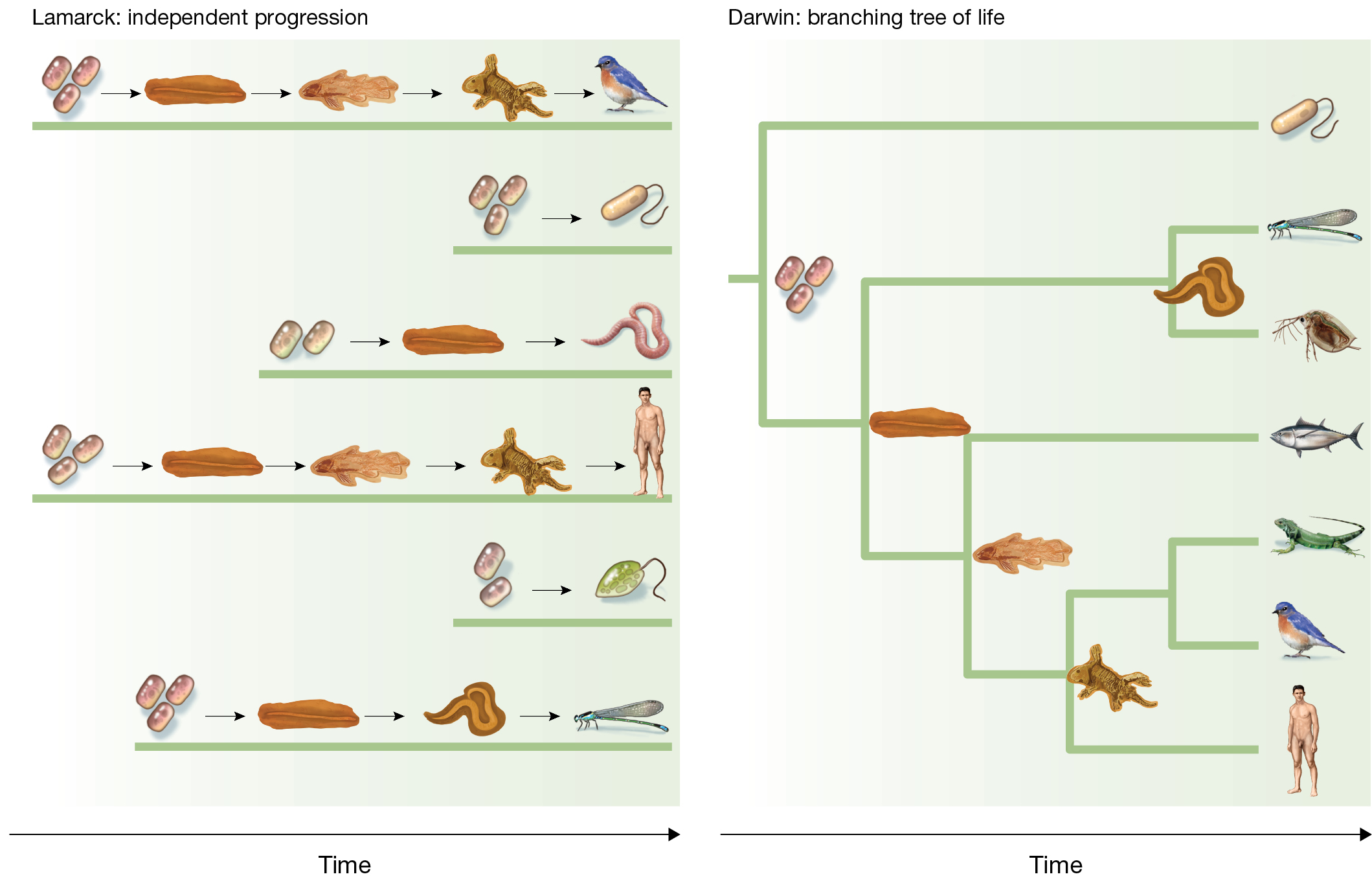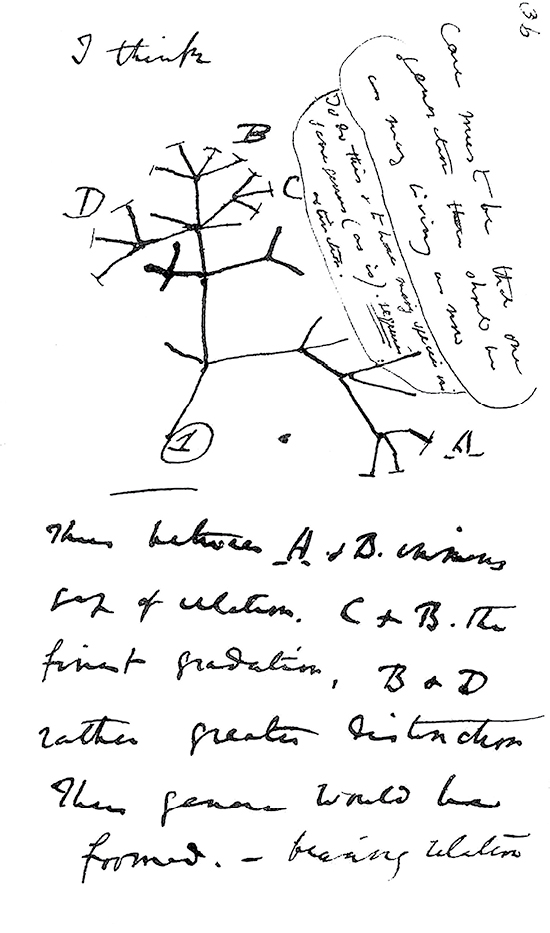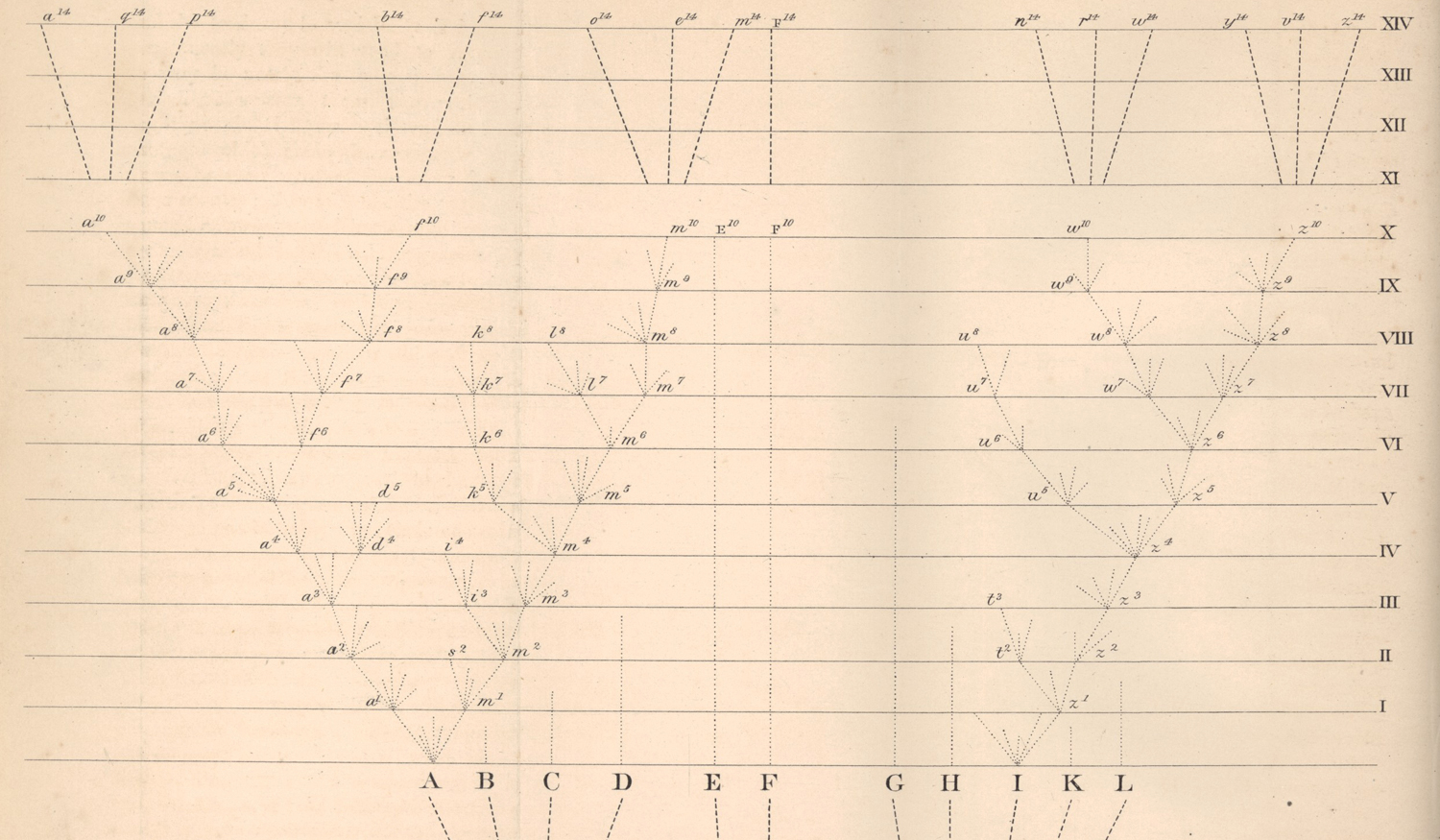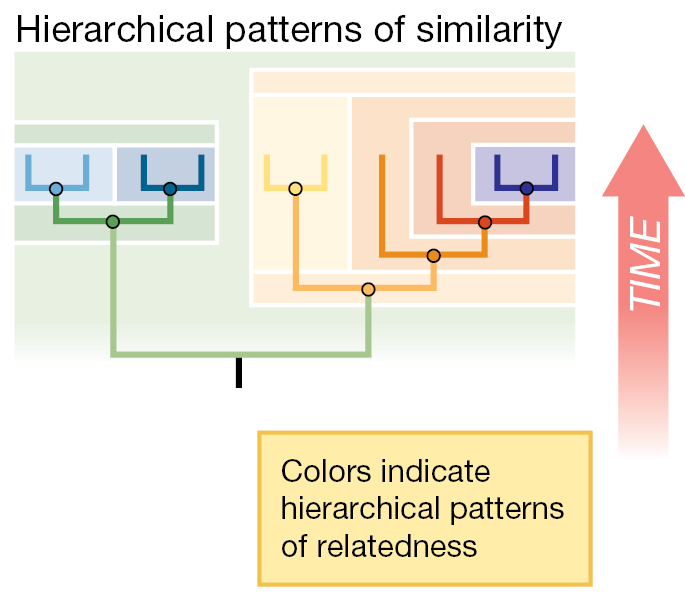2.7Darwin on Common Ancestry
We now turn to the second of Darwin’s revolutionary insights, his answer to the question: Where do species come from? Darwin correctly recognized that all living creatures derive from one or a few common ancestors and that new species are formed when populations of a preexisting species diverge from one another.
The Tree of Life
In On the Origin of Species, Darwin explained that just as artificial selection can create multiple new varieties from a single domesticated variety, natural selection can, over time, generate multiple new species from a single ancestral species. Indeed, Darwin conjectured that the vast diversity of species that we see throughout the world has arisen from precisely this process.
Darwin’s explanation suggests that all living things are linked by a pattern of descent dramatically different from that implied by either special creation—the idea that each species was created in its current form by a supernatural deity—or Lamarck’s theory of evolution (Figure 2.12). While these latter explanations envision species as a set of independent organisms, Darwin’s theory links species according to their historical pattern of descent.

More information
Two theories of evolution represented in two diagrams. Lamarck’s theory of independent progression shows everything linearly and by itself. There are six lines showing the evolution of a bird, microbe, worm, human, microbe, and dragonfly. The bird and human’s paths are the same except for the end. It starts with cells to a worm, to a fish, to an amphibian then to either a bird or human. The two different microbes both are just cells to a microbe. The earthworm’s path goes from cells, to a worm, to longer earthworm. The dragonflies path starts with cells, to a worm, to a longer worm to a dragonfly. Darwin’s branching tree of life shows cells split between microbes and worms. Worms splits between larger worms and fish. Larger worms splits between dragonflies and beetles. Fish splits between fish and amphibians. Amphibians split between mammals, birds, and reptiles.

More information
A handwritten sketch of a phylogenetic tree with cursive writing below it and notes on the side of it.
Darwin described the branching historical relationships among all living things using the metaphor of a tree of life (Figure 2.13). His eloquent depiction of the tree of life requires us to look at a lengthy quote, but this quotation is worth reproducing because of the profound implications of the tree of life metaphor:
The affinities of all the beings of the same class have sometimes been represented by a great tree. I believe this simile largely speaks the truth. The green and budding twigs may represent existing species; and those produced during each former year may represent the long succession of extinct species. . . . The limbs divided into great branches, and these into lesser and lesser branches, were themselves once, when the tree was small, budding twigs. . . . Of the many twigs which flourished when the tree was a mere bush, only two or three, now grown into great branches, yet survive and bear all the other branches; so with the species which lived during long-past geological periods, very few now have living and modified descendants. From the first growth of the tree, many a limb and branch has decayed and dropped off; and these lost branches of various sizes may represent those whole orders, families, and genera which have now no living representatives, and which are known to us only from having been found in a fossil state. . . . As buds give rise by growth to fresh buds, and these, if vigorous, branch out and overtop on all sides many a feebler branch, so by generation I believe it has been with the great Tree of Life, which fills with its dead and broken branches the crust of the earth, and covers the surface with its ever branching and beautiful ramifications. (Darwin 1859, pp. 129–130)
Darwin recognized the enormous importance of the branching relationships among species in this tree of life as a model for both life’s history and the patterns of life’s diversity. He chose to include only a single figure in On the Origin of Species, and this figure serves to illustrate the branching historical relationships among all living things (Figure 2.14). Today, we refer to this type of figure as a phylogenetic tree.

More information
A complex phylogenetic tree example with no specific animals or plants on it. It illustrates the pattern of branching relationships among a number of initial populations labeled A through L over vast periods of time notated on the right side of the page from 1 to 14. Each change in number moves time forward to another age where different evolutions are present.
Groups within Groups
The hypothesis of common ancestry with branching descent explains a key observation: In nature, we observe hierarchical patterns of similarity. By hierarchical patterns of similarity, we mean something like this: Different species of squirrels resemble each other more than they resemble any species of deer. And different species of deer resemble each other more than they resemble any species of squirrel. That is, species of squirrels cluster together because of their similarity to one another, and species of deer cluster together. At a different hierarchical level, species of squirrels and deer are more similar to one another than either is to a species of frog. And so, at this hierarchical level, species of squirrels and deer cluster together (as mammals), and species of frogs, toads, and salamanders cluster together (as amphibians). Finally, squirrels, deer, frogs, and toads are all more similar to one another (as vertebrates) than they are to species of octopus or squid (invertebrates).

More information
A phylogenetic tree showing hierarchical patterns of similarity. Each branch has a colored box around it to show the similarity between all the branches. There are no animals or plants listed on this tree. As time progresses, the first branch splits them into two distinct clusters. The left cluster is dark green and splits into two clusters of two each. The left cluster of two is light blue and the right cluster of two is dark blue. Back to the first branching and looking at the right side of the tree you have the second branching as light orange while the two subsequent branches are yellow and dark orange. Yellow stops there but the right side of orange branches to make red. Red’s right side branches to make purple while reds left side ends there.
In On the Origin of Species, Darwin argues that branching descent explains this hierarchical patterning seen in nature, writing that “the forms of life throughout the universe become divided into groups subordinate to groups” (Darwin 1859, p. 59). Neither special creation nor a theory such as Lamarck’s can explain these groupings and subgroupings of organisms. But a process of branches dividing and subdividing naturally gives rise to a hierarchical structure of relationships—varieties nested within species within genera (a genus, the singular of genera, is a taxonomic group, intermediate in scale between species and families), and so on up to domains. Indeed, the modern field of systematics—the naming and classification of organisms—is based on the conceptual foundation of this hierarchical branching structure. As we will see in further detail in Chapter 4, evolutionary systematists aim to classify organisms into hierarchically arrayed groups, or clades, of organisms that have descended from a common ancestor (Figure 2.15).
Darwin’s view of common descent provides an explanation not only for the hierarchy of organisms now studied by systematists but also for the clustering of species: “No naturalist pretends that all the species of a genus are equally distinct from each other,” Darwin wrote (Darwin 1859, p. 57). We expect to see clusters at many levels, including that of the genus, and Darwin reasoned that this clustering arose as a result of common ancestry. Groups of closely related species share common characteristics, in large part because they share a recent common ancestor.
Common Descent and Biogeography
Both Wallace and Darwin traveled extensively across the globe, and in doing so, both were struck by the strong patterns that they observed in the geographic distribution of nature’s diversity. In his 1855 paper that preceded Darwin’s On the Origin of Species by 4 years, Wallace noted that living species tend to be similar to other species that are geographically nearby, and that species from the fossil record tend to be most similar to species that lived around the same time. In other words, species that closely resemble one another tend to be closely clustered in time and space, and from this observation Wallace proposed that “Every species has come into existence coincident both in space and time with a pre-existing closely allied species” (Wallace 1855, p. 186).
Wallace recognized that this pattern of descent—new species coming into existence from previous species—implies the branching system of phylogenetic relationships that we have just described in detail. Like Darwin, Wallace proposed a tree metaphor in which groupings of species form a “complicated branching of the lines of affinity, as intricate as the twigs of a gnarled oak or the vascular system of the human body” (Wallace 1855, p. 187).
Darwin came to similar conclusions about the causes for groupings of species based on similar evidence. In On the Origin of Species, Darwin notes that similarities in “conditions of existence”—climate and physical conditions, for example—are insufficient to explain the geographic clustering of similar, closely related species. Instead, he thought that geographic features seemed to play an important role. He described the following pattern: Species separated by major geographic barriers to migration—mountain ranges, deserts, or large bodies of water—tend to be dissimilar even when the climate and physical conditions are similar on each side of the divide. Adjacent species that are not separated by geographic barriers tend to be similar to one another despite major differences in climate and habitat.
Darwin found some examples that seemed to violate the tenet that species separated by major geographic barriers to migration tended to be dissimilar, and he wanted to understand why. For example, while on the Beagle, Darwin took note of how similar plants on mainland South America were to those on nearby islands. But the ocean separated the mainland and islands, and plants can’t swim. The ocean, then, should be a major geographic barrier, and plants on the mainland and island should not be all that similar. The solution, Darwin posited, was that while the ocean can be a major geographic barrier to plant dispersal, in this case it was not because seeds could survive in salt water and be transported by ocean currents to islands. Darwin even ran a series of experiments in which he tested whether seeds soaked in salt water survived to germinate, and found that they did (Darwin 1855a, b; 1857). Darwin also hypothesized that bivalves from the South American mainland might be transported to the islands when adhering to the mud-soaked feet of ducks, and evidence he had gathered from other friends supported this (Darwin 1882). Species separated by true geographic barriers to migration do tend to be dissimilar, but Darwin discovered that one must be very careful about what constitutes a true geographic barrier.
These geographic correlations supported Darwin’s theory that each species arises only a single time in a single place, by descent with modification from a closely related species. Darwin then proposed the grandest uniformitarian extrapolation in the history of science. From these patterns he observed among groups of related species, Darwin hypothesized that in fact all living things have descended, with modification, from one or a few common ancestors. If so, all living things—plants, protozoa, humans, birds, insects, and every other life-form—share a common origin. In the next few chapters, we will explore the overwhelming weight of evidence that has since accumulated in support of Darwin’s conclusion. But first, we will consider some of the problems with his theory of descent with modification that troubled Darwin in his lifetime.
Glossary
- systematics
- The scientific study of classifying organisms.